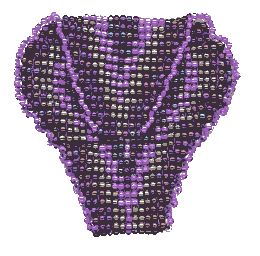 The color
combination choices are: Shades of Purple, Burgundy and Topaz, Shades of Blue, Green and
Blue Aquas and the original Gold and Silver. Refer to the color reference chart to match
up the color codes C1 thru C5 in the loom instructions.
The color
combination choices are: Shades of Purple, Burgundy and Topaz, Shades of Blue, Green and
Blue Aquas and the original Gold and Silver. Refer to the color reference chart to match
up the color codes C1 thru C5 in the loom instructions.
Bargello Purse
on a Bead Loom
A Beadwrangler Workshop
| Most of you have already seen the pattern for the Bargello Pendant and many of you have made one for yourself. The purse pattern will be very easy if you already made the pendant because part of the pendant portion is incorporated into the purse. I am including five color combinations and the listing of importer reference numbers so your bead store can match up the colors for you. All beads are size 11 seed beads and rocailles. |
 The color
combination choices are: Shades of Purple, Burgundy and Topaz, Shades of Blue, Green and
Blue Aquas and the original Gold and Silver. Refer to the color reference chart to match
up the color codes C1 thru C5 in the loom instructions.
The color
combination choices are: Shades of Purple, Burgundy and Topaz, Shades of Blue, Green and
Blue Aquas and the original Gold and Silver. Refer to the color reference chart to match
up the color codes C1 thru C5 in the loom instructions.

Supplies
Notes
For Beginners - The Bead Loom
If you have never woven on a bead loom, use the basic directions that came with your
bead loom; use the step-by-step directions in Bead & Button June 1994 issue starting
on page 11; or get the book, Those Bad Bad Beads by Virginia L.Blakelock at your local
bead store or mail $15 plus $2.00 postage to Virginia L. Blakelock, 16510 S.W. Edminston
Rd, Wilsonville, OR, 98070, or call her at (503) 625-7168. I am currently writing a
step-by-step book on basic and advanced bead and fiber weaving on a loom plus other
techniques. Watch for more information here at Beadwrangler’s Bead and Fiber
Junction.
For Beginners - Warp and Weft
Once you have put all your warp threads on your loom you will put beads onto your weft
thread and go left to right if you are right-handed; or right to left if you are
left-handed. Your weft threads are single threaded on your needle. See instructions below
for placement of your weft thread onto the warp.
For Beginners - Weaving Technique
When you begin weaving, do not pull your weft threads super tight each time you have
finished a row or you will have a buckling of beads when you take them off your loom. You
need only make sure your weft thread has been pulled through straight and ready for the
next row.
Advanced Weavers
I am sure you will use whatever techniques you regularly use. You can skip all the
finishing techniques if you prefer and use the illustration that is included.
Classic vs Traditional Weaving
I will be using instructions for classic weaving rather than traditional where the
threads show on one edge of the loomed piece. Graphics are included to show you decreasing
and increasing for the classic look which I prefer. You weave your purse whichever way you
like.
Weaving Instructions for the Purse
You will need to put 32 warp threads onto your loom before you start. I prefer
Silamide Thread for all my warp and weft threads, however, you can use any beading thread
you choose. Your first row of beads will begin at the opening of the purse and will
progress down through the flap. The purse is all one piece. When finished weaving, you
will secure the top opening and bottom flap first before taking your purse off the loom.
Then you will pull the warp threads on each side of the purse to pull it together and then
weave in all the warp and weft threads. Try to keep from catching your needle on your warp
threads as you put each row on. It will be much easier to pull your threads on each side
and form the purse if you do not catch the threads.
Length of Weft Threads
How long do I need to make the thread? I begin with a really long length of thread,
about two and a half yards, because I want to add as few weft threads to the purse as
possible. It takes approximately two times this length to make the whole piece, so I only
put weft thread on two times. That leaves fewer weft threads to weave back into the purse.
However, some people do not like to work with such a long thread and may prefer to add
more pieces of weft thread.
Adding weft thread
Make sure you have enough thread left on your needle to weave through a couple of rows
of loomed beads before you cut off the thread. Then put new thread on your needle again
and tie your weft thread onto the "current" (selvage edge) warp thread on which
you will be adding beads. You can again begin to weave. You can weave in all your weft
threads after you pull your purse side warp threads through. All decreasing and increasing
is by one or two beads on each side of each row. Note: A minus sign in parenthesis
indicates decreasing and the number of beads to decrease from the row on each side. A plus
sign in parenthesis indicates increasing and the number of beads to increase on each side.
Check the illustrations for increasing and decreasing.
Color Combinations
Colors will be listed as Color 1 which begins from the outside, Color 2 is the second
color added, Color 3 is the third Color added and so on. It will be shown as C1, C2, C3,
C4 and C5 as Color 1 through 5 and then the number of beads listed. Example: The first row
would be C1-2, C2-2, C3-2, (C4-2, C5-3, C4-3, C5-3, C4-2) C3-2, C2-2, C1-2. This
translates to Color 1 two beads, Color 2 two beads, Color 3 two beads, Color 4 two beads,
Color 5 three beads, Color 4 three beads, Color 5 three beads, Color 4 two beads, Color 3
two beads, Color 2 two beads, Color 1 bead. The letter R indicates rows. Brackets are
around the beads that change in each row. The beginning and ending beads that do not
change in number are outside of the brackets.
You can print the row list and mark each color number with a color pencil to match your beads. Then keep your beads lined up in row of 1 through 5 to match up with your colors on the list. It will be easier to follow. I would also take a ruler and put it on the pattern or on the list where you are working. Both sides are the same combinations and meet in the middle so lefties and righties can follow the directions from left to right.
Increasing Instructions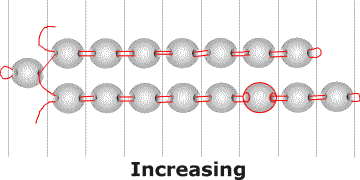
To increase you will need to add the number of beads you are increasing to the current
line of woven beads. Example: You have 20 beads in a line and have already gone through
them. Your next line of beads is going to be 4 beads longer for a total of 24 beads; that
is two beads longer on each side. You would add two more beads past the 20 and go back
through those two beads only and out again. You will take your needle down below the warp
threads before beginning to add the 22 beads to finish the line. However many beads you
are increasing per line on each side will be the same number of beads you will have to add
and go through before starting the rest of the next line of beads.
Decreasing Instructions
To decrease you will need to go back into the last bead you put on and out again
before adding the next decreased line of beads. Example: You have 20 beads on a line and
have gone back through them all. Now you need to decrease by one bead on each side. Take
your needle and go around the thread at the end of your last bead of the 20 and then go
back into the bead hole of the last bead and out again. Now take your thread below the
warp threads. Begin adding your next 18 beads and you will be one bead over to begin the
row. However many beads you are decreasing will be the same amount of beads you will have
to go back through before starting the next line of decreased beads.
Virginia Blakelock's book, Those Bad Bad Beads and The Beadworker's Journal, Loom Issue, produced by Alice Scherer at the Center for the Study of Beadwork were my sources for information on classical increase and decrease on the loom.
Looming the Purse, Part 1
START HERE: To begin, put your first weft thread onto your fourth warp thread from the outside edge (selvage edge). After your first row of beads are on your loom you should have three spaces open to the left and right of them. OK, go for it!
REMEMBER EACH ROW IS REPEATED TWICE EXCEPT ROW 11 WHICH WILL BE REPEATED 7 TIMES!
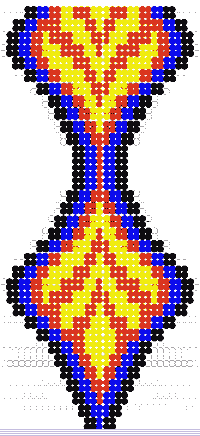 R1:C1-2, C2-2, C3-2 (C4-2, C5-3, C4-3, C5-3, C4-2)
C3-2, C2-2, C1-2 TWO ROWS
R1:C1-2, C2-2, C3-2 (C4-2, C5-3, C4-3, C5-3, C4-2)
C3-2, C2-2, C1-2 TWO ROWS
Begin Increasing
R2:C1-2, C2-2, C3-2, (C5-2, C4-4, C5-2, C4-1, C5-2, C4-4, C5-2)C3-2, C2-2, C1-2(+2 both sides)TWO ROWS
R3:C1-2, C2-2, C3-2 (C4-1, C5-4, C4-3, C5-3, C4-3, C5-4, C4-1)C3-2, C2-2, C1-2(+1 both sides)TWO ROWS
R4:C1-2, C2-2, C3-2 (C4-3, C5-4, C4-2, C5-1, C4-2, C5-4, C4-3)C3-2, C2-2, C1-2 (No Increase or Decrease) TWO ROWS
Begin Decreasing
R5:C1-2, C2-2, C3-2 (C4-4, C5-3, C4-3, C5-3, C4-4)C3-2, C2-2, C1-1 (-1 both sides)TWO ROWS
R6:C1-2, C2-2, C3-2 (C4-4, C5-2, C4-1, C5-2, C4-4)C3-2, C2-2, C1-2 (-2 both sides)TWO ROWS
R7:C1-2, C2-2, C3-2 (C4-3, C5-3, C4-3)C3-2, C2-2, C1-2 (-2 both sides)TWO ROWS
R8:C1-2, C2-2, C3-2 (C4-2, C5-1, C4-2)C3-2, C2-2, C1-2(-2 both sides)TWO ROWS
R9:C1-2, C2-2, C3-2, (C4-3)C3-2, C2-2, C1-2 (-1 both sides)TWO ROWS
R10:C1-2, C2-2, (C4-1)C2-2, C1-2 (-1 both sides)TWO ROWS
R11:C1-2, C2-2, (C3-1)C2-2, C1-2 (-1 both sides)(NOTE: REPEAT THIS ROW 7 TIMES)
Begin Increasing
R12:C1-2, C2-2, (C3-3)C2-2, C1-2 (+1 both sides)TWO ROWS
R13:C1-2, C2-2, C3-2, (C4-1)C3-2, C2-2, C1-2 (+1 both sides)TWO ROWS
R14:C1-2, C2-2, C3-2, (C4-3)C3-2, C2-2, C1-2 (+1 both sides)TWO ROWS
R15:C1-2, C2-2, C3-2, (C4-2, C5-1, C4-2)C3-2, C2-2, C1-2 (+1 both sides)TWO ROWS
R16:C1-2, C2-2, C3-2, (C4-3, C5-3, C4-3)C3-2, C2-2, C1-2 (+2 both sides)TWO ROWS
R17:C1-2, C2-2, C3-2, (C4-4, C5-2, C4-1, C5-2, C4-4(C3-2, C2-2, C1-2 (+2 both sides)TWO ROWS
R18:C1-2, C2-2, C3-2, (C4-4, C5-3, C4-3, C5-3, C4-4)C3-2, C2-2, C1-2 (+2 both sides)TWO ROWS
R19:C1-2, C2-2, C3-2, (C4-3, C5-4, C4-2, C5-1, C4-2, C5-4, C4-3)C3-2, C2-2, C1-2 (+1 both sides)TWO ROWS
R20:C1-2, C2-2, C3-2, (C4-1, C5-4, C4-3, C5-3, C4-3, C5-4, C4-1)C3-2, C2-2, C1-2 (No Increase or Decrease)TWO ROWS
Begin Decreasing
R21:C1-2, C2-2, C3-2, (C5-2, C4-4, C5-2, C4-1, C5-2, C4-4, C5-2)C3-2, C2-2, C1-2 (-1 both sides)TWO ROWS
R22:C1-2, C2-2, C3-2, (C4-2, C5-3, C4-3, C5-3, C4-2)C3-2, C2-2, C1-2 (-2 both sides)TWO ROWS
This is the beginning of the flap portion; continue decreasing
R23:C1-2, C2-2, C3-2, (C5-2, C4-5, C5-2)C3-2, C2-2, C1-2 (-2 both sides)TWO ROWS
R24:C1-2, C2-2, C3-2, (C4-5)C3-2, C2-2, C1-2 (-2 both sides)TWO ROWS
R25:C1-2, C2-2, C3-2, (C4-3)C3-2, C2-2, C1-2 (-1 both sides)TWO ROWS
R26:C1-2, C2-2, C3-2, (C4-1)C3-2, C2-2, C1-2 (-1 Both sides)TWO ROWS
R27:C1-2, C2-2, (C3-3)C2-2, C1-2 (-1 both sides)TWO ROWS
R28:C1-2, C2-2, (C3-1)C2-2, C1-2 (-1 both sides)TWO ROWS
R29:C1-2, (C2-3)C1-2 (-1 both sides)TWO ROWS
All finished? It takes about 4 hours to weave the complete piece. Phew! You may want to take a break before continuing.
Looming the Purse, Part 2
All ready? OK. Get another beading needle and go to the purse opening, middle area. Carefully take off one of the loops from your loom in the very middle of the purse opening. You may have to loosen the tension a little. Cut the loop in the middle and put your needle on one of the loose threads and weave it into the first row of the purse opening and go to one end and through the next bead line. Then take the other loop thread piece on your needle and go the opposite direction in the first row of your purse opening and then into the second line of beads. Do this with three of the loops so your top line of beads will not come apart while you are pulling side threads. Now go to the bottom of the purse flap and do the same with the very end of the flap on the middle loop. Now you can take the piece off your loom.
Pulling the threads: Turn your purse so it is doubled and the widest sides match up. Now go to the first warp thread loop sticking out on one side at the bottom; gently pull it upwards from the top and hold the two sides of the purse as you do it. You should be able to pull it up so no warp thread shows at the purse bottom and the purse side stays together. MAKE SURE YOU DO NOT PULL A WARP THREAD COMPLETELY OUT OF THE PIECE! If you hold onto the whole purse piece while you pull the warp and watch how the warp thread is moving you can make sure you are not pulling it out of the piece. If possible, do not cut each loop until you are ready to weave it in. This will insure that you do not pull out a warp thread.
Yes I have done it; I fiberjest you not and it wasn't pretty.
Keep doing this until you have pulled all the warp threads on one side all the way up to where the purse opening meets the beginning of the flap. Then go the the other side of the purse and do the same thing. When you have all the threads pulled, begin from the outside warp thread, cut the loop in half and weave the warps threads into the piece. You should be able to weave the warp threads straight around the purse from one side to the other and then cut off the excess. After you have woven in both sides then do the same with all the other warp and weft threads. In order make the fringe around the purse, you will need to keep the bead holes on the very outside around the whole purse open enough for additional thread to come through. When you are finished you should have a purse pulled together and the flap should drop over the opening.
Whaaaaa! My thread broke or is too short to weave back into the purse. Yes, that can happen. If the thread is on one of the sides you can tie it into a knot. If your thread is nylon like Silamide you can use a BIC lighter to make a bead on the end of the knot and it will be protected. If you have a broken thread in the middle of the piece it will be much more difficult. If one of your warp threads breaks, try and line up another whole warp thread in the same place.
Now you should have all the warp and weft threads woven in and are ready to embellish the outside of the purse. Check the optional embellishment if you do not want to do the two part embellishment.
Embellishing the Purse, Part I
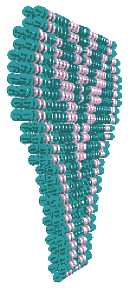 Note: Make sure you look at the purse
illustrations while continuing the embellishing.
Note: Make sure you look at the purse
illustrations while continuing the embellishing.
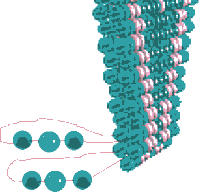 You will begin by putting new thread onto your
beading or sharps needle. I use a sharps needle for the small stuff; a bead or two at a
time. Put about 40" of thread on and double the thread. Put a knot in it. Use the BIC
trick if you like on the end. Then go to the bottom of the purse, opposite the flap, on
one side. Take your needle and go through one row of loomed beads all the way to the other
side and come out through the bead on the other end. You will now be attaching three beads
at a time from one side to the other on the purse beginning at the bottom. Add one Color
1, one Color 3 and one Color 1 beads and go directly into the bead across from it. Come
out the bottom of the bead and go up into the next bead beside it and back out. Add three
beads and go back into the bead on the opposite side. Then back up the bead beside it and
back out. Continue adding three beads as you go all the way around the purse. You will
find that as you go up the purse body adding three beads, you have some areas that
increase by two beads, so you will have to go up through those two beads in the purse edge
to get to the next row before adding the three beads on the outside.
You will begin by putting new thread onto your
beading or sharps needle. I use a sharps needle for the small stuff; a bead or two at a
time. Put about 40" of thread on and double the thread. Put a knot in it. Use the BIC
trick if you like on the end. Then go to the bottom of the purse, opposite the flap, on
one side. Take your needle and go through one row of loomed beads all the way to the other
side and come out through the bead on the other end. You will now be attaching three beads
at a time from one side to the other on the purse beginning at the bottom. Add one Color
1, one Color 3 and one Color 1 beads and go directly into the bead across from it. Come
out the bottom of the bead and go up into the next bead beside it and back out. Add three
beads and go back into the bead on the opposite side. Then back up the bead beside it and
back out. Continue adding three beads as you go all the way around the purse. You will
find that as you go up the purse body adding three beads, you have some areas that
increase by two beads, so you will have to go up through those two beads in the purse edge
to get to the next row before adding the three beads on the outside.
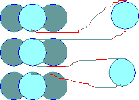

 When you come
to the purse flap portion you will be putting on the three beads in one thickness. Put on
three beads like before but go sideways, from one row to the next adding beads. When you
come to the other side of the purse section, begin again adding three beads across until
you get to the bottom. This gives the purse one additional bead on each row of loomed
beads and one sticking out in the middle. Continue around the whole purse until you are to
the other end. When finished, you may need to put on new thread.
When you come
to the purse flap portion you will be putting on the three beads in one thickness. Put on
three beads like before but go sideways, from one row to the next adding beads. When you
come to the other side of the purse section, begin again adding three beads across until
you get to the bottom. This gives the purse one additional bead on each row of loomed
beads and one sticking out in the middle. Continue around the whole purse until you are to
the other end. When finished, you may need to put on new thread.
Note: The end of the purse flap edge does not have any beads added across for embellishment.
Embellishing the Purse, Part II
Now go to the bottom end of the purse on one side again and come up through the first Color 3 bead, put on another Color 3 bead and go through the next Color 3 bead already on the purse, continue all the way around the purse until you come to the purse flap portion. You will have to add two Color 3 beads between all the rows from the purse opening upward on the flap. Then you will go back to one bead added when you get around to the purse section again. You need two beads between all the flap rows to keep the flap flat when held open. The added beads give the whole purse edge a ruffled effect.
Optional Embellishment
Instead of going around the purse two times, you can just begin at the bottom of the
purse on one side and put on 3 to 5 beads and go to the other side. You can continue all
the way around this way if you like. I like the first way better even though it takes more
time because it is more secure, especially if you decide to use this purse inside a larger
purse and want to make sure the beads are not likely to come off from movement in the
larger purse.
If you want the little purse to be carried in a larger purse I would make an attachment for the purse flap to open and close such as a snap or a beadwoven piece across the flap attached to either side of the purse where the flap could slip into it. If you are going to wear the purse as an amulet then you can just let the flap hang and do not need a closure.
Purse strap
There are several possibilities. You could make a simple strand or two of beads going
from one side of the purse to the other; beadweave a flat strip to attach to each side of
the purse and wear around your throat with a snap or velcro closure at the back; peyote or
brick stitch a strap. See my examples for ideas.
Note: I was going to include instructions to do this purse using the picking method and pulling all the warp threads from one side to the other; however, I found that when using the classical technique you can not pull the threads in the end without catching them all. It would require more instructions and graphics to explain this technique and I believe it will only work with traditional bead weaving. It is demonstrated in some of the Japanese bead weaving books, but on a rectangular piece with no increasing or decreasing steps. I have used it on rectangular pieces but am still experimenting with shaped forms. When I finish experimenting and write complete instructions, I will put it up on the workshop or in a booklet.
| When you make copies of these instructions to share with your friends, please tell them you got them at Beadwrangler's. |